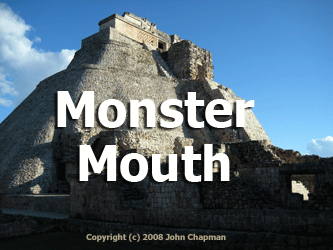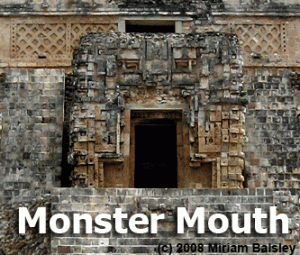My Super-scary Memory of Atlantis
My super-scary Atlantis reincarnation memory had to do with falling into the mouth of a snake. The snake’s mouth looked like the entrance to the underground. As I said in When We Were Gods:
“I looked down at the tunnel or hole in the ground that looked like the mouth of a snake. It even had two fangs in the upper jaw.”
Carol Chapman, When We Were Gods
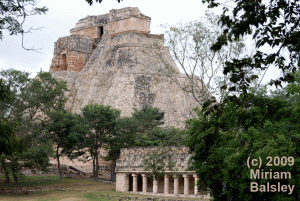
Uxmal Monster Mouth sits just below the top of the Pyramid of the Sorcerer. (Close up above right.) Copyright 2009 Miriam Balsley, Used with Permission
Of course, you have to realize that when I fell into the mouth of the snake, it occurred in the time before my Light Body inhabited a physical form. This was the time before reincarnation. In fact, I called myself a Semi-solid Encapsulated Light Being. It represented one of the stages from our being pure Light Beings (or souls) to our present relationship with the physical in human bodies. For a greater in-depth description of our history as souls on earth, please read When We Were Gods.
Since my memories of this time seem so bizarre, I’m always looking for corroboration of my past life memories of Atlantis. In fact, because Edgar Cayce said that Atlanteans traveled to Yucatan, I’ve been to Yucatan six times now. During my visits, I’ve looked for sculptures and legends that resonate with my reincarnation memories.
Therefore, you can imagine my excitement when I found this August 15, 2014 Seeker.com article describing the exploration of an archaeological expedition led by Ivan Sprajc of the Research Center of the Slovenian Academy of Sciences and Arts.
Archaeologist Describes Monster Mouth Doorway
Sprajc said that the ancient Maya built monster mouth doorways to represent an entrance into a cave and also the underworld. In a Seeker.com article, Sprajc describes the monster mouth doorway as:
“It represents a Maya earth deity related with fertility. These doorways symbolize the entrance to a cave and, in general, to the watery underworld. . .”
The article goes on to say that:
“One of the cities featured an extraordinary facade with an entrance representing the open jaws of an earth monster.”
Location of the Campeche Monster Mouth Doorway
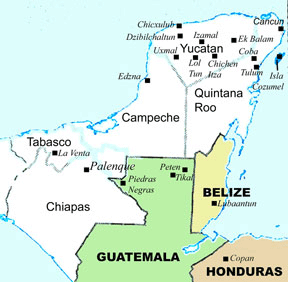
The Mexican State of Campeche in the Yucatan Peninsula. You can see Uxmal, Chichen Itza, and Ek Balam in the Mexican State of Yucatan.
In addition, thick jungle hid the ruins, making them difficult to find on the ground. In the Seeker.com article, Sprajc says that he and his group used aerial photography to help them locate the ancient cities Tamchen and Lagunita, which contains the Monster Mouth doorway
Sprajc has explored in this area since the 1990s. The southeastern part of the Mexican State of Campeche is an area of the Yucatan Peninsula far from well-known ruins such as Chichen Itza, Tulum, and Uxmal. On the map of the Yucatan Peninsula, right, I’ve marked many well-known Mayan ruins.
The Slovenian-led expedition found the monster mouth doorway and the Lagunita and Tamchen ruins in August 2014. Therefore, who knows when they’ll be ready for tourists to visit? Right now, based on my previous experiences in Yucatan, there might not even be a proper road into the archaeological sites.
As a result, I don’t have photographs of the actual monster mouth doorways at these sites. However, I do have a couple of monster mouth photographs from other Mayan ruins, namely Uxmal and Ek Balam. I’ve used these photos to illustrate this piece.
Ek Balam Monster Mouth Boasts Giant Fangs
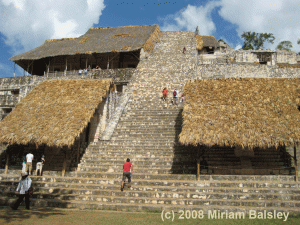
The Ek Balam Monster Mouth is protected by the top left overhanging roof. Photo by and Copyright 2008 Miriam Balsley, Used with Permission
I visited the relatively newly-opened ruin of Ek Balam, also in the State of Yucatan, which is shown on the map above. Ek Balam contains a magnificent Monster Mouth Doorway built into the side of its main pyramid, photo left. The Ek Balam Monster Mouth doorway leads into a burial chamber. The ancient Maya sculpted giant fangs along the side and bottom of the Ek Balam Monster Mouth.
This Monster Mouth doorway displays another characteristic of the monster mouth doorway found recently by Sprajc in Lagunita, namely, giant fangs.
In the quote from When We Were Gods, above, I noted that the doorway into the underground sported giant fangs.
Similarities of Monster Mouth and Memories of Atlantis
Therefore, not only does the monster mouth lead to the underground, but it also represents an earth monster–a living creature–which has giant fangs. Now, the Mayan Monster Mouth ruin agrees with my Atlantis memories on three counts:
- It leads to the underground
- It represents the open jaws of a creature
- The jaws have giant fangs
Did Atlanteans Build the Mayan Monster Mouth Doorways?
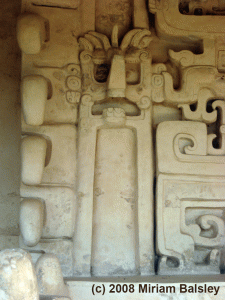
Close up of Left side of Ek Balam Monster Mouth showing fangs or teeth. Photography by and copyright 2009 Miriam Balsley, Used with Permission
Sprajc dates the Monster Mouth doorway in Lagunita and surrounding ruins as having been built in what archaeologists call the Late and Terminal Classic period, dated from 600 to 1000 AD.
As a result, you may be wondering why I consider these Monster Mouth doorways as representative of my past life memories of Atlantis. Did the Atlanteans build these monster mouth doorways?
They could not have. According to Plato, Atlantis sunk into the sea around 9,000 BC. Therefore, how could the Monster Mouths of 600 to 1000 AD be associated with the Atlanteans of 9,000 BC?
I believe the memory of that time when Atlanteans explored Yucatan became embedded in the local people’s minds as legends. Because of the magnificence and power of the Atlanteans, these myths took on a religious significance. As a result, the mythical memories of that time have been immortalized in ancient Mayan ruins.
Who knows what the ancient Maya believed their monster mouth doorways to represent? They could very well have been the giant, fanged mouths of serpents. After all, the Mayan ruins contain many images of feathered serpents, including many with men in the feathered serpents mouths. This would be an exact representation of my Atlantis memories.
